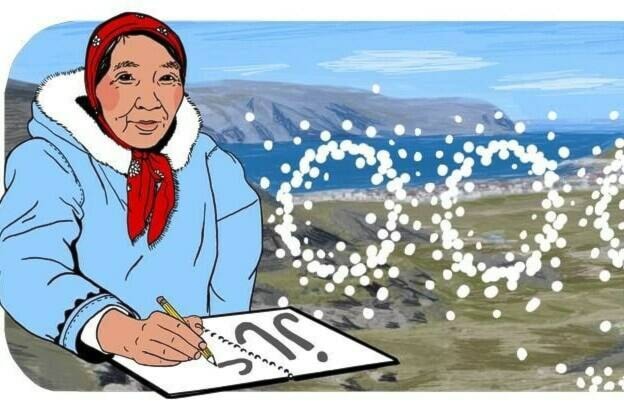Visitors to Google’s home page on National Indigenous Peoples Day get a chance to learn about late Inuk author Mitiarjuk Nappaaluk.
Nappaaluk is featured in Wednesday’s Google Doodle, a temporary interactive feature on the site that celebrates people, holidays, events and anniversaries. Google says she is being celebrated for her work preserving Inuit culture and language.
“I’m so happy Mitiarjuk Nappaaluk is being honoured in this Google Doodle and that I could help spread awareness of her contribution to our history,” said Inuk artist Gayle Uyagaqi Kabloona of Ottawa, who illustrated the Doodle.
“I know millions of Canadians will see the Doodle, and I’d like to think that ‘Canada’ can go through a rebranding as an Indigenous nation.
“But I don’t create for people who need to learn; I create for my own community. I’m thrilled that younger generations of Inuit will be able to see themselves represented in their own country.”
Google also worked on the project with Inuk author and researcher Norma Dunning, who has studied and written about Nappaaluk.
“I think it’s wonderful,” said Dunning, an instructor at the University of Alberta. “Any kind of Indigenous exposure and information going out in our country in whatever form of media is very much welcomed. And especially this one, because it’s positive and it’s a look at a beautiful life.”
Nappaaluk was born in 1931 near Kangiqsujujuaq in the Nunavik region of northern Quebec and was raised with traditional Inuit teachings.
She learned to write in Inuktitut syllabics from Catholic missionaries in the 1950s, and she taught them the language and helped translate scriptures. She went on to write more than 20 books on Inuit traditions, knowledge, stories and language, many of which are used in schools across Nunavik.
Nappaaluk is best known for writing “Saanaq,” one of the first Inuktitut novels, which tells the story of an Inuit family dealing with changes brought on by colonization.
While Nappaaluk never attended school, she was devoted to education and had a strong sense of obligation to younger generations of Inuit, Dunning said.
Along with preserving Inuit traditions and language in her works, Nappaaluk was a consultant with the Kativik School Commission between 1965 and 1996.
She was also a mother, grandmother and soapstone carver. She died in her home community in 2007.
“She had a lot of concern for the children in her communities, so I think of her as someone who was everybody’s mother,” Dunning said.
Nappaluk received many accolades for her work. In 1999, she was the recipient of a National Aboriginal Achievement Award, now known as the Indspire Award, in the culture, heritage and spirituality category.
She also received an honorary doctorate from McGill University in 2000 and was named a member of the Order of Canada in 2004. She alsowon the Mary Scorer Award for best book by a Manitoba publisher.
The Sanaaq cultural and community centre in downtown Montreal, named after her novel, is expected to open in 2024.
Dunning said she hopes the Google Doodle inspires people to learn about and reflect on Nappaluk’s life, particularly the younger generation.
“I really hope that the rest of Canada recognizes how Inuit people are educated and that Indigenous knowledge counts and is on par with Western knowledge,” she said.
“We’re modern-day people. We are professional people. We are writers and artists and doctors and nurses.”
This report by The Canadian Press was first published June 21, 2023.
